 Aquatic Insects of Michigan
Aquatic Insects of Michigan
by Ethan Bright, Museum of Zoology Insect Division and School of Natural Resources and Environment
University of Michigan
- Home
- Species Lists
- Coleoptera
- Diptera
- Ephemeroptera
- Acanthametropodidae
- Ameletidae
- Ametropodidae
- Arthropleidae
- Baetidae
- Baetiscidae
- Behningiidae
- Caenidae
- Ephemerellidae
- Ephemeridae
- Heptageniidae
- Isonychiidae
- Leptohyphidae
- Leptophlebiidae
- Metretopodidae
- Neoephemeridae
- Oligoneuriidae
- Palingeniidae
- Polymitarcyidae
- Potamanthidae
- Pseudironidae
- Siphlonuridae
- Heteroptera
- Hymenoptera
- Lepidoptera
- Megaloptera
- Neuroptera (Sisyridae)
- Odonata
- Orthoptera
- Plecoptera
- Trichoptera
- Other Orders
- Keys/Identification
- Aquatic Insects of Michigan
Brillia (Orthocladiinae) of Michigan - Identification
A widely distributed genus of Orthocladiinae, with one species - Brillia flavifrons (Johannsen) definitively recorded from Michigan, and another widely ranging species - Brillia parva Johannsen - expect to occur here based on its known distribution (widely ranging in eastern North America but occurring as far west as the eastern Lake Superior shore in Ontario) (Oliver and Roussel 1983). Larvae, with a distinctively large mentum, are either miners in allochthonous woody debris, or shredders of similar leafy material. The key below is adapted from Oliver and Roussel 1983. Generally, Brillia flavifrons (Johannsen) adults are distinguished by a distinctly banded abdomen, whereas those of Brillia parva Johannsen lack such banding. However, as Oliver and Roussel (1983) point out, such banding may be absent, especially from teneral (recently emerged) specimens, or those specimens preserved in alcohol and/or slide-mounted. Thus, for adults, it is suggested that one run through the keys below to verify a specimen's identity.
Adults
| 1a | Males |
2 |
| 1b | Females | 3 |
| 2a(1a) | a. Gonostylus with a subapical lobe about 1/2 as long as the apical lobe (Fig. 1) | Brillia flavifrons (Johannsen) |
| b. Abdomen usually banded, with the posterior part of each tergite distinctly lighter in color than the anterior part | ||
| also: AR > 1.5 | ||
Fig. 1 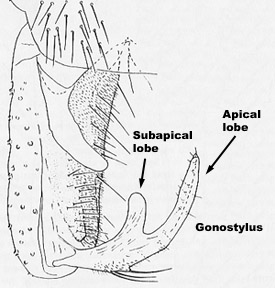 Fig. 2 Fig. 2 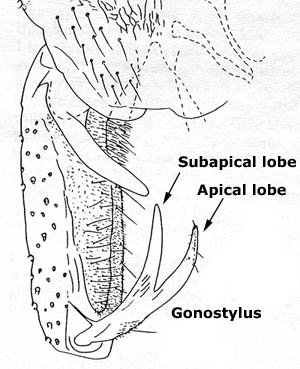 |
||
| 2b | a. Gonostylus with a subapical lobe subequal in length, usually a little longer than the apical lobe (Fig. 2) | Brillia parva Johannsen |
| b. Abdomen not banded | ||
|
||
| 3a(1b) | a. Frontal setae on head present | Brillia flavifrons (Johannsen) |
| b. Abdomen usually banded, with the posterior part of each tergite distinctly lighter in color than the anterior part | ||
| also: b dark internal projection extending anterior from the vaginal opening (Fig. 3); hinge not bly sclerotized | ||
Fig. 3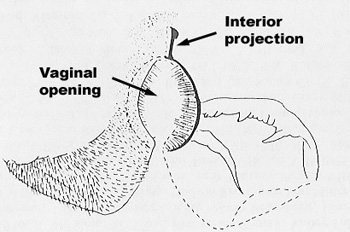 Fig. 4 Fig. 4 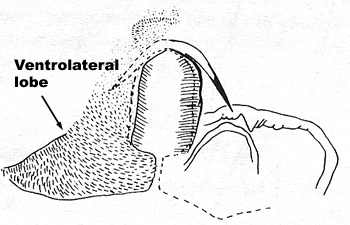 |
||
| 3b | a. Frontal setae on head absent | Brillia parva Johannsen |
| b. Abdomen not banded | ||
| also: Ventrolateral lobe of gonapophysis VIII relatively short, not overlapping but continuous with the area lateral to the vaginal opening (Fig. 4) | ||
Pupae
| 1a | Thoracic horn short, tapering to a point (Fig. 5) | Brillia flavifrons (Johannsen) |
| also: Posterior margin of Ab8 tergite with or without sparsely distributed spinules (Fig. 6) | ||
Fig. 5 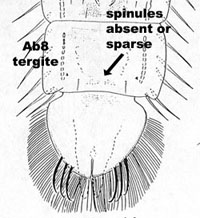 Fig. 6 Fig. 6 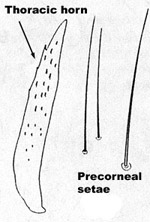 |
||
| 1b | Thoracic horn long, broad, and with an irregular or bifid apical margin (Fig. 7) | Brillia parva Johannsen |
| also: Ab2 tergite with gray to brownish polygons between the shagreen and hooklets | ||
Fig. 7 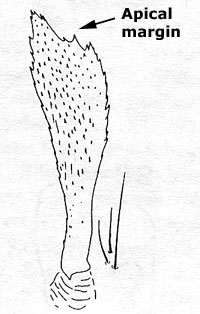 |
||
Larvae
| 1a | a. Labral sclerite Sl 2 divided into 3 or 5 parts (Fig. 8) | Brillia flavifrons (Johannsen) |
| b. Blackish-brown or black marking between the eye spot and the bases of the antenna and mandible | ||
| also: Labral sclerite Sl 1 narrowly separated or fused medially, the distance between the median apices < 8 µm | ||
Fig. 8 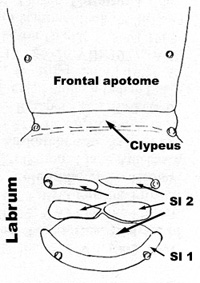 |
||
| 1b | a. Labral sclerite Sl 2 entire | Brillia parva Johannsen |
| b. No such markings between the eye spot and the bases of the antenna and mandible | ||
| also: Mentum with the fifth lateral tooth smaller than the sixth lateral tooth | ||
References
Oliver DR, Roussel ME. 1983. Redescription of Brillia Kieffer (Diptera: Chironomidae) with descriptions of Nearctic species. The Canadian Entomologist 115:257-279.
Page created: March 27, 2006 - Last updated: November 9, 2013 (EB)